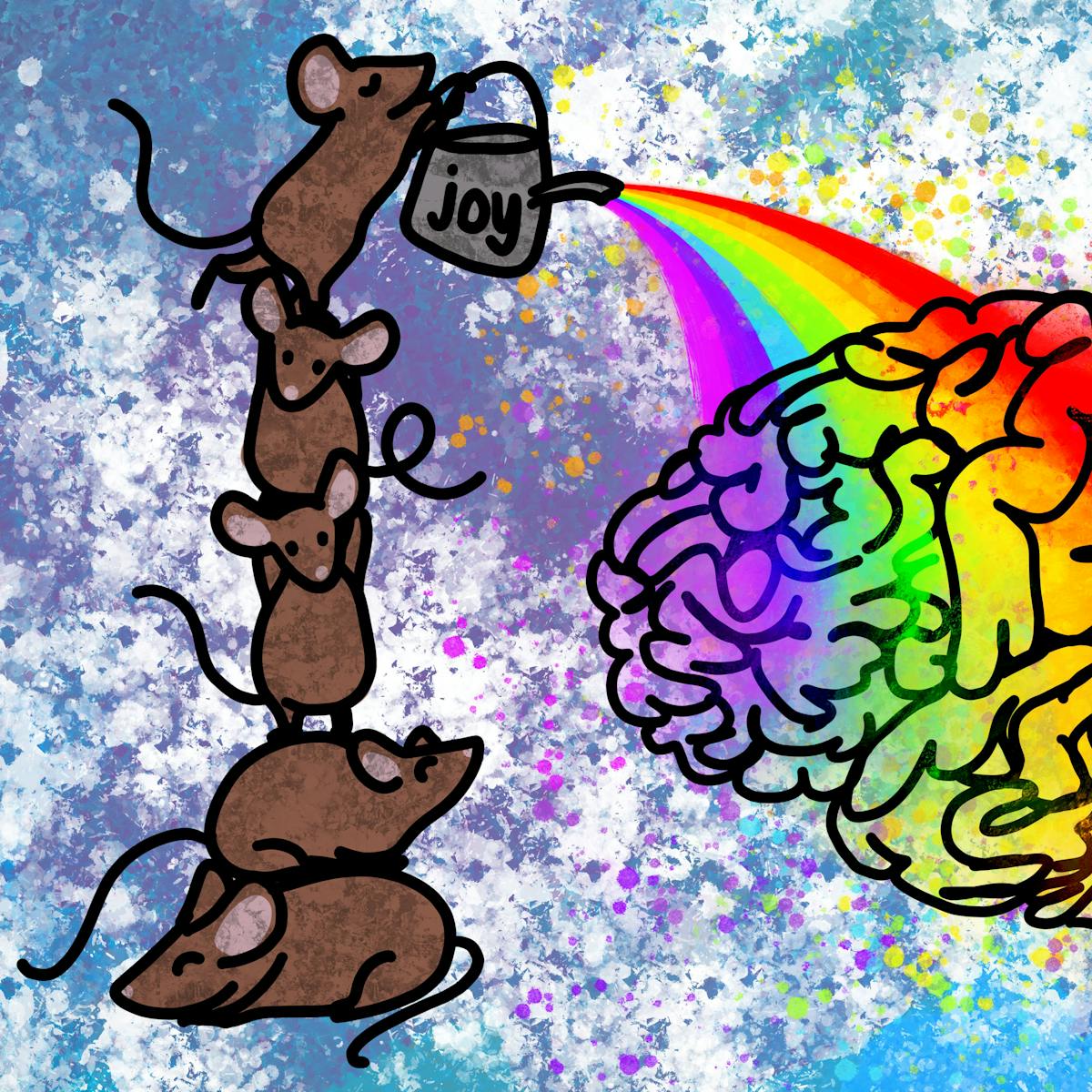Research by a team of scientists who played hide-and-seek with lab rats suggests that play and the associated joy of interacting with others doesn’t just feel good – it can be a powerful motivator for learning and social bonding.
The joy of playing hide-and-seek with rats
Words by Professor Sophie Scottartwork by Jem Clancyaverage reading time 6 minutes
- Article

I love that I get to study human brains and human behaviour for a living – it’s an honour to get to work in such a continually interesting area of science. However, I can still read about someone else’s research and be incapacitated by jealousy at what they get to do. I experienced this quite acutely in September 2019 when I read an article about the scientists who taught rats how to play hide-and-seek and spent their days playing the game with the rats.
This study revealed that the rats could learn to play hide-and-seek – they learned to hide in places where they could not be seen, and to not always hide in the same place, and they learned to switch roles and become the seeker when the scientist hid from them. This indicates a very sophisticated understanding of the ‘rules’ of the game, as well as the ability to adopt strategies, role-play (hider or seeker) and consider their opponent’s perspective – the rats would often run and hide in a place where they’d just seen the hunter look.
Playing for fun
The rats were taught to play the game by reinforcement. Reinforcement is a very common way of shaping behaviour when studying animals in the lab – you reward the behaviour that you want to see with things of value to the animal (positive reinforcement), or you penalise the behaviour you do not want to see (negative reinforcement).
In this case, the rats were rewarded both when they were hiding and were found by the experimenter, and when they were seeking and found the experimenter. However, unlike most reinforcement learning paradigms, the rats were not rewarded with food or water: they were rewarded with a ‘playful’ interaction with the experimenter, who would tickle and play with them.
In case you are wondering what a delighted rat looks like, they do Freudensprung or ‘joy jumps’, and produce high-frequency trills and chirps.
Rats are very playful and enjoy being tickled, but they soon started to play the game for sheer fun, and the scientists found that the discovery of a hiding rat was often accompanied by the rat streaking straight off to hide again, so that they could continue to play the game.
Joy jumps
The rats would appear delighted to be found and to find. In case you are wondering what a delighted rat looks like, they do Freudensprung or ‘joy jumps’, and produce high-frequency trills and chirps (too high for us to hear). Rats are not the only animals to jump for joy, and this can be seen when many animals play, including goats, dogs, ferrets and humans.
Playful behaviour is one of clearest manifestations of joy. Play is often dismissed by adults as a ‘pointless’ activity, as there is frequently no reason or reward for playing – it doesn’t get you fed or made safe. However, the point of play and much of the value of play is that it is an end in itself. It is rewarding and fun to play, to feel playful.
And far from being trivial, play is a very important behaviour. It has been argued that play is a default state for children; if they are not doing something else (or being made to do something else), they will start to play, such that the absence of play may be an indication that something is wrong.
The value of positive emotions
From a scientific perspective, play is linked to social joy, and it’s probably safe to say that we know more about play/social joy in other mammals than we do in humans – and we know a lot less about positive emotions than negative emotions in general, though these are arguably more important in our day-to-day behaviour. We can see the value of positive emotions in learning – positive reinforcement is much more effective than negative reinforcement as an incentive to learn.
And playful, joyful social contact may be even more rewarding than the food and/or drink that is usually used as a reinforcement in animal learning studies. The rats in the hide-and-seek study were taught an incredibly complex task but were only ever rewarded with playful social contact, to which they reacted with joy. And after a while, the joyful experience of simply playing the game was a reward in itself.
The role of joy as a reward is backed up by brain studies. Joy is associated with activation in the ventral striatum, an area of the brain associated with reward processing. This strongly suggests that the experience of joy is a powerfully rewarding experience.
Sharing moments of joy
As we get older, how do we find ways of incorporating joy into our lives? Teenagers stop playing ‘games’ around the age of 14, though the start of secondary school can bring this down to around 11. Of course, they don’t stop feeling social joy, but it becomes more associated with conversations and interactions with their social network.
For older teens and adults, most laughter (an index of social joy) is found in conversations, and these conversations and interactions form the basis for our wider social network.
Our interactions with the people in our social network and sharing playful moments of joy with them never stop being important. In a recent study of how older adults who live in a care home experience joy in their life, the most important factor was associated with positive interactions with the other people who lived in their home, how happy they felt themselves, how engaged they felt and how meaningful their lives felt.
We have much more to learn about joy, and I suspect that as scientists we will have to start by taking it seriously as a powerful motivator for human social behaviour, and one that is critical to our wellbeing over our whole life span. To take joy seriously means to take human connection seriously, and not to diminish the importance of positive emotions in our lives, but if my experience studying laughter has been any guide, the research is going to be a lot of fun on the way. Possibly even joyful.
About the contributors
Professor Sophie Scott
Sophie is the Director of the Cognitive Neuroscience at University College London. She studies human brains and human communication. She is particularly interested in how we use our voices in social interactions, and has done a lot of work on laughter and its use in communication. She gave the Royal Society Christmas Lectures in 2017.
Jem Clancy
Jem is a visual and movement artist based in Leeds. She is passionate about dance and art as a means to communicate and connect with others. As a disabled artist she is particularly keen to embrace and promote diversity and inclusion throughout her work, in all processes and product. She is currently an associate artist with the Tetley Art Gallery and works at Northern Ballet supporting the Academy and the delivery of Ability, a weekly training course for adults with learning disabilities, in the Learning team.

